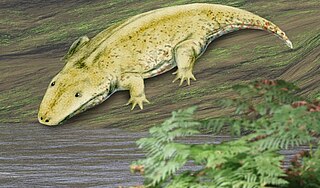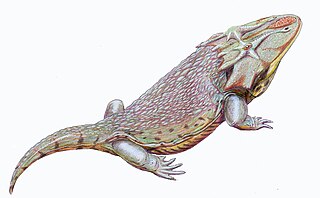
Dissorophidae is an extinct family of medium-sized temnospondyls that flourished during the late Carboniferous and early Permian periods. The clade is known almost exclusively from North America.

Temnospondyli or temnospondyls is a diverse ancient order of small to giant tetrapods—often considered primitive amphibians—that flourished worldwide during the Carboniferous, Permian and Triassic periods, with fossils being found on every continent. A few species continued into the Jurassic and Early Cretaceous periods, but all had gone extinct by the Late Cretaceous. During about 210 million years of evolutionary history, they adapted to a wide range of habitats, including freshwater, terrestrial, and even coastal marine environments. Their life history is well understood, with fossils known from the larval stage, metamorphosis and maturity. Most temnospondyls were semiaquatic, although some were almost fully terrestrial, returning to the water only to breed. These temnospondyls were some of the first vertebrates fully adapted to life on land. Although temnospondyls are amphibians, many had characteristics such as scales and armour-like bony plates that distinguish them from the modern soft-bodied lissamphibians.

Platyhystrix is an extinct temnospondyl amphibian with a distinctive sail along its back, similar to the unrelated synapsids, Dimetrodon and Edaphosaurus. It lived during the boundary between the latest Carboniferous and earliest Permian periods throughout what is now known as the Four Corners, Texas, and Kansas about 300 million years ago.

Cheliderpeton is an extinct genus of temnospondyl amphibian. It lived during the Early Permian in what is now Europe. Fossils have been found from the Ruprechtice horizon of the Intrasudetic Basin of Bohemia in the Czech Republic, as well as the Saar-Nahe Basin of southwestern Germany. Cheliderpeton had a 16 cm skull, and reached about 65 cm in length.

Intasuchus is an extinct genus of temnospondyl amphibian from the Middle Permian of Russia. It is known from a single species, Intasuchus silvicola, which was named in 1956. Intasuchus belongs to the family Intasuchidae and is probably its sole member, although other taxa such as Syndyodosuchus and Cheliderpeton have been assigned to the family in the past. Intasuchus most likely belongs to the group Archegosauroidea, Permian relatives of the large, mostly Mesozoic temnospondyl clade Stereospondyli.

Saharastega is an extinct genus of basal temnospondyl which lived during the Late Permian period, around 251 to 260 million years ago. Remains of Saharastega, discovered by paleontologist Christian Sidor at the Moradi Formation in Niger, were described briefly in 2005 and more comprehensively in 2006. The description is based on a skull lacking the lower jaws.

Laidleria is an extinct genus of temnospondyl that likely lived between the Early to Middle Triassic, though its exact stratigraphic range is less certain. Laidleria has been found in the Karoo Basin in South Africa, in Cynognathus Zone A or B. The genus is represented by only one species, L. gracilis, though the family Laidleriidae does include other genera, such as Uruyiella, sister taxon to Laidleria, which was discovered and classified in 2007.

Dasyceps is an extinct genus of zatracheidid temnospondyl from the early Permian of England.

Zatrachys is an extinct genus of large and flat-headed zatracheidid temnospondyl from the early Permian of North America.

Trematopidae is a family of dissorophoid temnospondyls spanning the late Carboniferous to the early Permian. Together with Dissorophidae, the family forms Olsoniformes, a clade comprising the medium-large terrestrial dissorophoids. Trematopids are known from numerous localities in North America, primarily in New Mexico, Oklahoma, and Texas, and from the Bromacker quarry in Germany.

Anconastes is an extinct genus of dissorophoid temnospondyl within the family Trematopidae. It is known from two specimens from the Late Carboniferous Cutler Formation of north-central New Mexico in the southwestern United States. The genus name derives from two Greek roots, ankos and nastes ("inhabitant"), which refers to the type locality of El Cobre Canyon where the specimens were found. The specific name is derived from the Latin word vesperus ("western"). The more complete specimen, the holotype, is a partial skull with articulated mandibles and a substantial amount of the postcranial skeleton. The less complete specimen, the paratype, consists only of the right margin of the skull with an articulated mandible.

Acroplous is an extinct genus of dvinosaurian Temnospondyli within the family Eobrachyopidae.

Dissorophus (DI-soh-ROH-fus) is an extinct genus of temnospondyl amphibian that lived during the Early Permian Period about 273 million years ago. Its fossils have been found in Texas and in Oklahoma in North America. Its heavy armor and robust build indicate Dissorophus was active on land, similar to other members of the clade Dissorophidae that are known from the Late Carboniferous to the Early Permian periods. Dissorphus is distinguished by its small body size, disproportionately large head and short trunk.

Rhineceps is an extinct genus of temnospondyl amphibian in the family Rhinesuchidae. Rhineceps was found in Northern Malawi in Southern Africa known only from its type species R. nyasaensis. Rhineceps was a late Permian semi-aquatic carnivore that lived in streams, rivers, lakes or lagoons. Rhineceps is an early divergent Stereopondyl within the family Rhinesuchidae, which only existed in the late Permian (Lopingian) and failed to survive the Permian-Triassic extinction unlike other stereospondyl families.

Stegops is an extinct genus of euskelian temnospondyl from the Late Carboniferous of the eastern United States. Fossils are known from the Pennsylvanian coal deposits of Linton, Ohio. It was once classified in the eryopoid family Zatrachydidae because it and other zatrachydids have spikes extending from the margins of its skull, but it is now classified as a dissorophoid that independently evolved spikes. Stegops was first named by American paleontologist Edward Drinker Cope in 1885, with his description of the type species Stegops divaricata. Cope had also named a species of Sauropleura from Linton in 1875, which he called Sauropleura newberryi. This species was later synonymized with Stegops divaricata when the type specimen of S. newberryi was prepared and found to be a large specimen of Stegops.
Perryella is an extinct genus of dvinosaurian(?) temnospondyl from the Permian of Oklahoma.
Parioxys is an extinct genus of temnospondyl amphibian from the Early Permian of Texas.

Edopoidea is a clade of primitive temnospondyl amphibians including the genus Edops and the family Cochleosauridae. Edopoids are known from the Late Carboniferous and Early Permian of North America and Europe, and the Late Permian of Africa. They are among the most basal temnospondyls, and possess a number of primitive features that were lost in later members of the group.

Acanthostomatops is an extinct genus of zatracheidid temnospondyl from the Lower Permian Döhlen Basin of Saxony.

Branchiosauridae is an extinct family of small amphibamiform temnospondyls with external gills and an overall juvenile appearance. The family has been characterized by hundreds of well-preserved specimens from the Permo-Carboniferous of Middle Europe. Specimens represent well defined ontogenetic stages and thus the taxon has been described to display paedomorphy (perennibranchiate). However, more recent work has revealed branchiosaurid taxa that display metamorphosing trajectories. The name Branchiosauridae refers to the retention of gills.

























